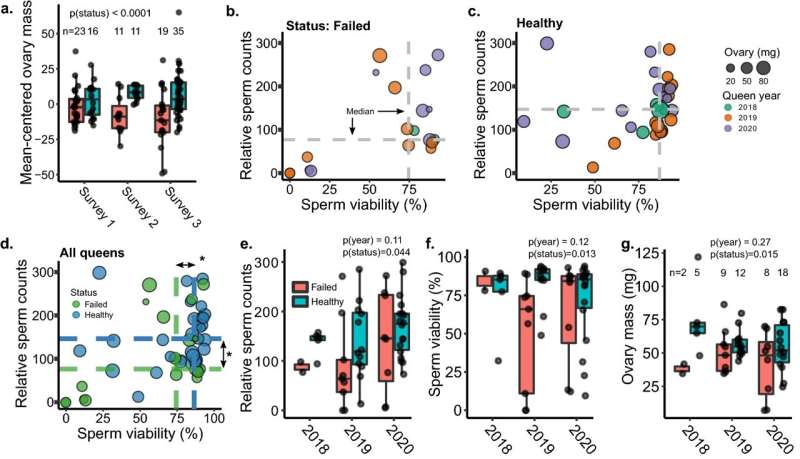Fertility metrics of failed and healthy queens. In all cases, years indicate the year the queen was reared. (a) Ovary masses of failed and healthy queens collected across three different surveys conducted in British Columbia and Pennsylvania (analyzed using a linear mixed model with status as a fixed effect and source location as a random effect). Because the average ovary size differed between surveys, data were mean-centered by survey prior to analysis to better highlight the effect of status. Boxes represent the interquartile range, bars indicate the median, and whiskers span 1.5 times the interquartile range. (b) Queens rated as ‘failed’ (spotty brood pattern, drone layer, or dwindling adult population) or (c) ‘healthy’ (contiguous worker brood patterns, medium-strong adult population) by local beekeepers in British Columbia were collected in the summer of 2020. Sperm viability and sperm counts were determined by fluorescent imaging, and wet ovary weight was measured on an analytical balance. (d) Statistical analyses on data presented in (b) and (c) were conducted using either a linear mixed model (ovary mass and sperm counts) or a generalized linear mixed model fitted by maximum likelihood (sperm viability). In the statistical models, queen age (0, 1, or 2 years, which corresponds to queens reared in 2020, 2019, and 2018, respectively) and health status (healthy or failed) were included as fixed effects and source location was included as a random effect. Asterisks indicate statistical significance (p < 0.05), with exact p values given in panels (e–g). (e–g) Same data as in (d) but separated by the year in which the queen was reared (i.e., a 2018 queen was 2 years old). Credit: Scientific Reports (2022). DOI: 10.1038/s41598-022-20330-4
Queen bees with viral infections have smaller ovaries than their healthy counterparts, a recent UBC study has found, which could threaten the health and financial viability of their colonies.
Viral infections in honey bees are becoming more intense and widespread. UBC researchers Abigail Chapman and Dr. Alison McAfee found that virus-infected queen bees in the field have shriveled ovaries compared with healthy ones. The researchers then infected queen bees in the lab with a different virus, and noticed the same result.
A queen's shrunken ovaries could mean fewer eggs, and so, fewer baby bees—something the researchers will investigate in future work. A smaller population would make a colony weak, affecting how much money beekeepers can make from it. Honey bees contribute an estimated $4 to $5.5 billion annually to the Canadian economy.
The researchers are in the very early stages of working on a "queen vaccine" to protect the bees. In the meantime, beekeepers are practicing COVID-style measures to prevent virus spread, including quarantining sick colonies and sterilizing equipment. Local governments could help by subsidizing PCR tests to help beekeepers identify which colonies are sick, says Chapman.
The research was published in Scientific Reports.
More information: Abigail Chapman et al, Fertility costs of cryptic viral infections in a model social insect, Scientific Reports (2022). DOI: 10.1038/s41598-022-20330-4
Provided by University of British Columbia
























